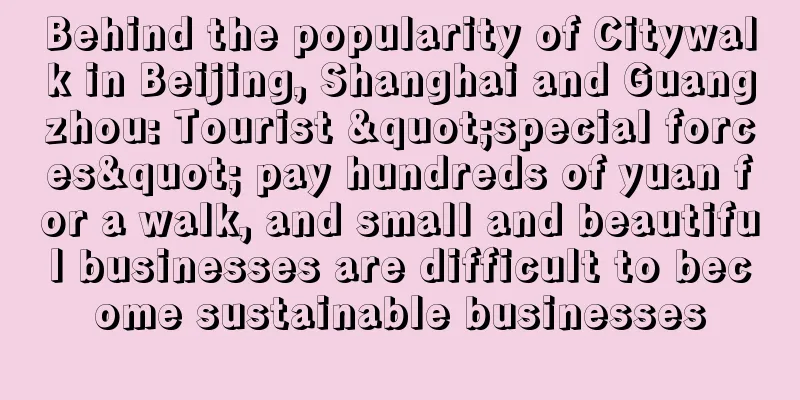Behind the popularity of Citywalk in Beijing, Shanghai and Guangzhou: Tourist "special forces" pay hundreds of yuan for a walk, and small and beautiful businesses are difficult to become sustainable businesses

While summer travel is still in full swing, the most popular form of tourism has changed from special forces travel to city walks. Data from multiple travel platforms including Ctrip, Qunar and Mafengwo show that since June, the number of searches or orders for City Walk has increased by 1 to 5 times, with products in Shanghai, Beijing, Xi'an and other places being popular. Related posts are also emerging on social media. So far, the number of notes tagged with #假期citywalk# on Xiaohongshu has exceeded 500 million views. Compared with the previous special forces travel that focused on high-intensity and fast-paced clocking in, City Walk emphasizes calmness, leisure, slow pace, and immersive experience of the city. Like camping, Frisbee and cooking tea around the stove, City Walk, as an emerging lifestyle, has also made some people smell business opportunities. Currently, a number of paid City Walk products are gradually emerging on major social and e-commerce platforms. However, the scattered business entities and the difficulty in unifying product prices and service quality have made City Walk only "small and beautiful". City Walk related content on Xiaohongshu 1. Who is running the City Walk business?City walk originated in London, England. The original form was to walk along a planned route under the guidance of a guide to deeply experience the history, culture and landscape of a city. In contrast, the current descriptions of City walk on domestic social media are more associated with keywords such as casual, leisurely, and finding niche attractions. The birth of the "national version" of City Walk is in sync with the development of the domestic tourism industry. Shen Jiani, a senior researcher at the Strategic Research Center of Ctrip Research Institute, told the Times Weekly reporter that the rise of City Walk is related to the increasing popularity of "micro-vacation" modes such as short-distance, small-scale local tours during the epidemic. As people pay more and more attention to the sense of interaction and experience during the journey, City Walk has also become popular among young people and quickly integrated into urban tourism. As a result, a city walk business began to take shape in Beijing, Shanghai and Guangzhou. Currently, some paid City Walk products have appeared on social media. The providers of these products are generally professional urban research organizations, youth outdoor activity communities, and travel agency guides. In addition, some locals or people who have studied and worked in the local area for a long time also spontaneously participate in them. Not only are there many product providers, but the prices of City Walk products on the market also vary widely. Professional City Walk organizes city travelers, and the product price is 99 to 158 yuan per route. A licensed tour guide in Shanghai said that his City Walk service costs 600 yuan for 5 hours, and overtime will be charged at 100 yuan per hour. A girl who has been working in Guangzhou for 9 years told the Times Weekly reporter that she only provides services on weekends, and the charge is 35 yuan per hour. City Traveler Product Page 2. How long will it last?When City Walk developed into a new paid product, a question arose: How long can this business be popular? Can it be sustained for a long time? In 2021, Chen Yu (pseudonym) signed up for a City Walk organized by an independent urban research organization in Shanghai. He paid 129 yuan and followed the tour guide to visit the French classical park, art deco style, science hall and statues at the intersection of Nanchang Road in two and a half hours. The content of this activity made Chen Yu appreciate the charm of City Walk: "The activity is very professional. At each destination, the tour leader will show historical pictures related to the scenic spots and even early urban planning maps of Shanghai. It is much more in-depth than the cursory tour explanation." After the event, Chen Yu recommended City Walk to many of his friends and looked forward to the next registration. However, a year later, the above-mentioned urban research organization stopped operating for some reason. Chen Yu’s experience reflects the market status of City Walk. Currently, city walk is still a niche activity. Chinese people often jokingly refer to this activity as "strolling", and there are very few providers of highly specialized city walk products. Therefore, there are few groups that provide professional city walk products and they do not form a large-scale system. The profitability of the groups themselves is also weak, making it difficult to ensure sustainable development. At the same time, the quality of products and services provided by various amateur City walk providers is difficult to guarantee. Take the products provided by tour guides and locals consulted by the Times Weekly reporter as an example. The above services often include helping to customize tour routes, accompanying guests to eat and play, and giving appropriate explanations of scenic spots. To some extent, this type of product focuses on the primary information gap and does not have core competitiveness. Therefore, the product is not only difficult to arouse people's desire to pay, but also not conducive to cultivating people's understanding of City Walk. Therefore, in the short term, City Walk is more suitable as a traffic-generating activity or a niche interest activity than merchandise. However, according to Ctrip platform data, from the demand side, a large proportion of people who book City Walk products are young travelers. As people born in the 1990s and 2000s become the main force of travel consumption, City Walk will become more and more popular. City Walk still has the prospect of being a small but beautiful business. However, before the paying population grows and professional products are stably supplied, City Walk still has a long way to go. Author: Li Xinting Source: WeChat public account "Time Weekly (ID: timeweekly )" |
<<: High-customer-per-bike company|Operational methodology for the entire user life cycle
Recommend
Video Account: An optional or mandatory option for creators?
The development of Tencent's video account has...
Private domain traffic operation, how to build personal IP? The key is these 5 steps
The author divides the private domain traffic oper...
Alipay is cracking down on illegal rentals. What are the tricks in rental mini-programs?
Recently, Alipay has rectified illegal rental mini...
What are the tips for setting up Amazon coupons? What are the uses of setting up?
The coupons on the Taobao platform correspond to c...
Does Temu's pricing include shipping costs? What shipping costs do Temu sellers bear?
When operating a store on the temu cross-border e-...
How to operate Shopee's 6.6 promotion? Operation strategy sharing
Shopee's 6.6 promotion is coming, and many sel...
Unveiling the quotes of AI digital humans: Can you make money from the quotes of the Douyin AI little monk and old man?
What is AI digital human quotes? How to produce AI...
Traffic Alchemy of AI Applications
This article mainly describes the current status o...
No more PPT, a great data analysis report template
In the business world, data analysis reports are a...
How does TikTok quickly locate traffic for product diagnosis?
As a TikTok merchant, do you want to know the stor...
There is traffic but no conversion? How to write high-conversion notes on Xiaohongshu?
What is the key to running Xiaohongshu? Decision-m...
Brand No. 1: 3 forms and 3 stages of seeding
Now everyone is aware of the importance of "p...
What is multidimensional data analysis? How to do it?
This article deeply analyzes the concept and pract...
The 7 most recent award-winning copywriting~
Many advertising awards have been announced recent...
Do copywriting that ChatGPT cannot replace
This article starts with the underlying logic of C...









